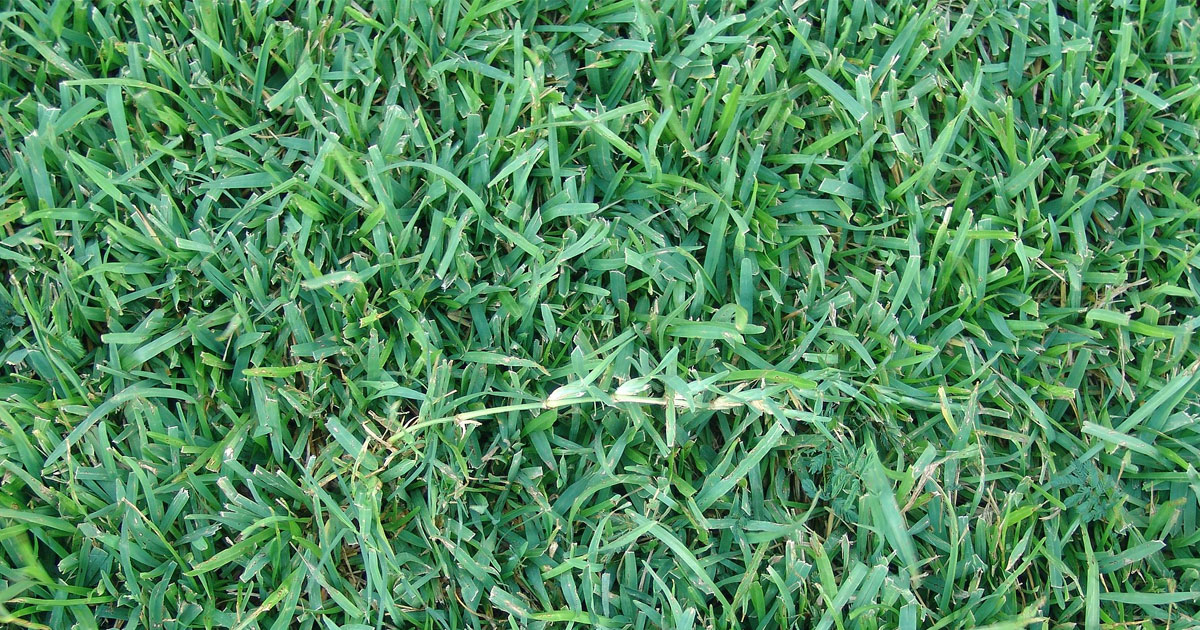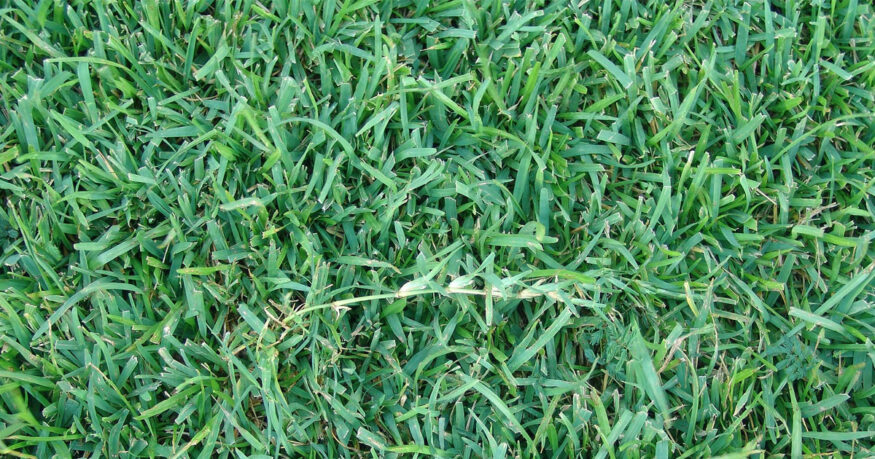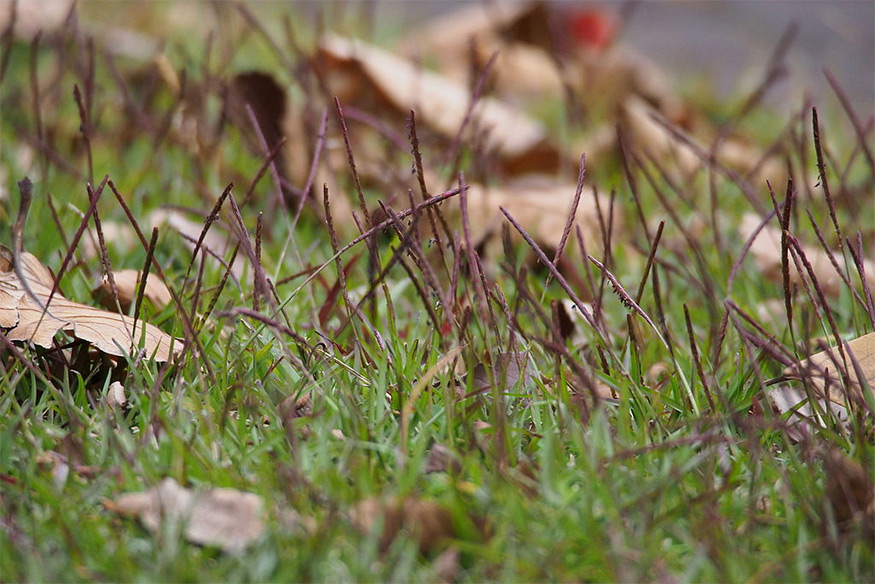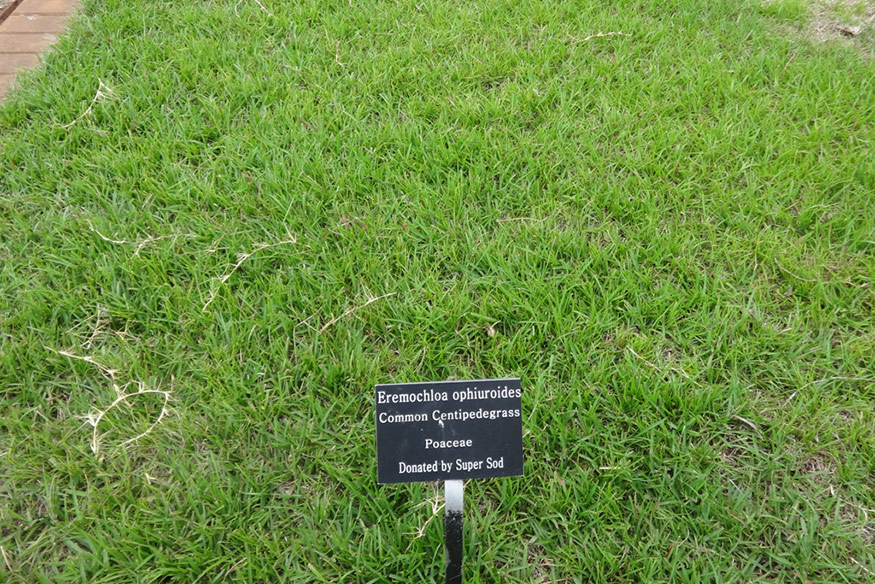Centipede grass is commonly known as “lazy man’s grass” because it requires little maintenance. But this turfgrass is only suitable for specific climates and requires certain environmental factors for optimal growth.
In this guide, we’ll look at important centipede grass characteristics to help you determine if it’s right for your yard. We’ll also tell you everything you need to know to care for this warm-season grass using our helpful lawn care calendar.
Centipedegrass Overview
| Also Known As | Lazy man’s grass; Eremochloa ophiuroides |
| Type of Grass | Warm season perennial |
| Optimal Zones | 7 – 10, South Eastern US; Hawaii |
| Root Structure | Shallow |
| Winter hardiness | Very poor |
| Heat tolerance | Excellent |
| Shade tolerance | Fair |
| Water Requirements | Moderate to High |
| Drought Tolerance | Moderate to High |
| Self Repair Capacity | Poor |
| Overall Maintenance Requirements | Low |
History
Centipede grass is native to Southern China. It first came to the US in 1916 after seed collectors returned from China with various options for turfgrass cultivators.
The fact that centipede grass can survive in sandy soils with little nutrients made it a promising candidate for home lawn use. But its requirements for acidic soils, high humidity, and warm winters restricted its use.
Compared to other warm-season turfgrasses, there are few varieties of centipede grass commercially available. That means, even today, its use is largely restricted to the Southeast where its needs are naturally met.
It is a great choice for mild climates from southern Texas, east through the lower parts of the southern states and up the coast to southern North Carolina. It also grows well in Hawaii. Because of alkaline soil and low precipitation, it is not a good option for the Southwest or California.
Centipede Grass Characteristics
Centipede grass takes time to establish and grows very slowly. But once it matures, it does an amazing job choking out weeds and surviving with very little input. But it is only an option in certain climates and when specific needs are met.
To help you decide if centipede grass is right for your yard, let’s take a closer look at the characteristics of this species.
Type of Grass
Centipede is a perennial warm-season grass. “Perennial” meaning it comes back every year. And “warm season” meaning it does most of its growing when temperatures are hot.
Unlike zoysia and bermudagrass, centipede does not go dormant in the winter.
Optimal Zones
Centipede grass is best suited for tropical and subtropical climates that do not experience cold winters. It also requires sandy, acidic soil. In the US, it grows best in the deep southeast and Hawaii.
Root Structure
The roots of centipede grass only penetrate up to 6 inches deep. It spreads slowly via stolons that put down roots wherever they contact the soil. These stolons help form thick mats of sod that keep weeds from growing.
Winter Hardiness
Because centipede grass does not go dormant in the winter, it is prone to frost damage. Temperature drops below freezing can cause damage and anything below 20 degrees will kill the grass.
Heat Tolerance
Centipede grass prefers hot, humid climates. Most growth occurs when daytime temperatures are between 80 and 95 degrees.
Shade Tolerance
This grass has more shade tolerance than most warm-season grasses. But it grows best with a minimum of 6 hours of direct sunlight per day.
Water Requirements & Drought Tolerance
Centipede grass requires about the same amount of water as most warm-season grasses. It needs about 1 inch of precipitation per week to grow well. It performs best with deep, infrequent waterings.
This species can survive longer periods without water than many grasses but will suffer with prolonged or frequent drought.
Self Repair Capacity
Centipede grass grows very slowly and is not suited to high foot traffic areas. It has a lower ability to self-repair than other grass options. It is also very sensitive to foot traffic and will die back with repeated use.
Centipedegrass Lawn Maintenance Calendar
Centipede grass may be the lazy man’s grass, but that doesn’t mean you don’t have to care for it. Most of the work required is in the first months after installation.
You can install centipede grass via seed, sprigs, plugs, or sod in the late summer. In all cases, it is important to provide plenty of moisture until the grass is well established.
Brand-new sod can be mowed after it reaches about 3 inches in length. At this point, you can begin following our centipede grass lawn maintenance plan, below.
Spring Care
Centipede grass will begin growing at a more predictable rate starting in mid to late spring. Maintenance at this time of year revolves around preparing the grass for more rapid growth in the summer.
Mowing
Centipede grass grows best at heights between 1 ½ to 2 inches. If your lawn encountered any winter die-off, set the mower to the lower setting and bag the clippings for the first mow of the season.
Mowing this time of year will likely need to be done about once per week. But do it as often as necessary to avoid taking off more than ⅓ of the blade length each time you mow. Also, be sure to use a sharp blade to avoid leaf damage.
Fertilization
Centipede grass does not require a lot of nutrients or nitrogen. Fertilization this time of year should only be done if there are major inadequacies diagnosed by a soil test.
Be especially careful about adding nitrogen in the spring. If rapid growth is followed by cold temperatures, major damage can occur.
Weed Control
Pre-emergent herbicide should be applied early in the spring, around mid-February to mid-March. Applying again in late April or early May will help further control weeds through the rest of the year.
Post-emergent weed killers should not be applied until after the grass is fully greened up. In the meantime, pull troublesome weeds by hand or use spot treatments. Be sure to check that the product you want to use is safe for sensitive centipede grass.
Watering
Irrigation is generally not needed in spring assuming at least 1 inch of rainfall per week. When supplemental watering is needed, water deep, up to 1 inch at a time.
Pest and Disease Control
When it comes to pests and disease control, Centipede grass is susceptible to mole cricket damage during warm springs. Unless the damage is severe, however, treatments should be delayed until summer when they will be more effective.
You should also check for excessive white grub activity by cutting a square of sod and peeling it back. More than 6 grubs in one square foot is a sign that treatment is needed. Use an insecticide spray in late spring.
Disease is typically not an issue this time of year.
Aeration and Dethatching
When kept consistently below 2 inches, thatch is typically not a problem for centipede grass. If you have allowed thatch to build up over ½ inch, use a dethatcher with 2 to 3-inch blade spacings to remove it. Narrower spacings will damage the lawn.
Spring is typically the best time to have your lawn aerated to avoid compact soil. However, this is not usually needed for centipede grass growing in sandy soil. Monitor water absorption and aerate only if compact soil becomes evident.
Overseeding
It can take up to 3 years for immature centipede grass lawns to create thick sod. Overseeding with more centipede seed in the late spring can help hasten this process.
Apply ⅛ to ¼ pound of seed per 1,000 square feet using a broadcast spreader. Water the lawn lightly multiple times per day to assure the soil stays wet until seeds have germinated and established. This can take six weeks or more.
Summer Care
Summer is when centipede grass grows the most. It will need careful monitoring to thrive.
Mowing
Continue mowing at a height between 1 ½ and 2 inches through the summer. Areas in shade will do better at higher heights while areas in full sun can be brought down to 1 inch if needed.
Centipede is slow growing even in summer and usually only needs to be mowed once per week or less. But be sure to mow often enough to only take ⅓ the blade length off at a time. Also, be sure to use a sharp blade to avoid leaf damage.
Fertilization
Centipedegrass is a unique kind of grass that has different needs compared to other turfgrasses.
Keeping your soil pH between 5.5 and 6.0 is important for optimal centipede grass growth. For soils with a higher pH, apply 5 pounds of pelletized sulfur per 1000 square feet to acidify the area.
When the pH level gets higher, the grass can’t get enough Iron, which makes it turn yellow.
If there’s too much phosphorus in the soil, Iron becomes unavailable too, and the grass turns yellow as well.
The foliage of centipedegrass is lighter green than most other turfgrasses, but if you give it too much nitrogen fertilizer, it can become dark green and start to decline. Too much nitrogen can also cause thatch build-up and disease problems for the grass.
In early summer, apply nitrogen fertilizer at a rate of ½ to 1 pound per 1,000 square feet. Sandy soils will need the higher amount while clay soils will need the lower one. Do not apply phosphorus unless your spring soil test showed a deficiency.
In late summer, apply nitrogen fertilizer at a rate of ½ to 1 pound per 1,000 square feet. For this application, be sure the fertilizer mix also contains equal amounts of potassium. This nutrient will help your centipede grass get through the winter.
Watering
The best way to coax deeper root growth from centipede grass is to only water it when it shows signs of moisture stress. It will take on a bluish color and won’t bounce back when walked on in the evening.
When this happens apply ¾ to 1 inch of water in a single watering. Early morning is the best time to do this.
In periods of no rainfall, you will likely have to water once a week. But it’s best to let the grass tell you when conditions are too dry.
Weed Control
Established centipede lawns rarely have problems with weeds, especially if a pre-emergent product was used in the spring. While slow growing, the grass forms a thick layer that weeds struggle to penetrate.
If you do see summer weeds pop through, apply a broadleaf herbicide in the early months after the grass is fully greened up but before daytime temperatures get over 90 degrees. This is only necessary if weeds are a problem. Choose a product safe for centipede grass.
Alternatively, you can pull weeds manually or use spot treatments as needed.
Pest and Disease Control
Pests can be a problem for centipede grass in the summer. The most common suspects are:
- Mole crickets
- Grubs
- Nematodes
- Spittlebugs
- Ground pearls
Each requires its own specific treatment, but most can be targeted this time of year. Keep an eye out for damage and treat only when necessary. If mole cricket damage was seen early in the year, now is the best time to treat to reduce future damage.
Large patch disease can occur in summer. This is typically a sign of too much moisture in the turf. Watering infrequently and just before sunrise will help. Thatch buildup can also contribute to damage from these funguses.
Repair
Bare spots in lawns should be addressed in early summer by planting seeds or sprigs as needed. Centipede grass can take up to a month to germinate and up to three years to form dense sod. Water lightly, multiple times per day until new grass has established.
Fall/Autumn Care
The fall season is all about preparing your centipede grass for winter.
Mowing
Continue mowing at your preferred summer height until nighttime temperatures cool to below 70 degrees. At this point, raise the mower to 2 inches all around to allow for more leaf surface.
As usual, make sure your blade is very sharp to avoid leaf damage.
Fertilization
Do not apply nitrogen fertilizer this time of year.
The most important nutrient for fall is potassium, as this will help centipede grass survive cold winter temperatures. If your soil test shows low potassium, add 1 pound of potash per 1,000 square feet about 5 weeks before the first expected frost.
While winterizer fertilizer can be helpful for cool-season lawns, it is not recommended for centipede grass in most cases.
Weed Control
Control winter annual weeds and invasive grasses by using a pre-emergent weed control spray in September and again in late November.
Watering
Watering is generally not needed in the fall. However, if there is not much rainfall, you may need to supplement as you did through the summer.
Disease Control
Keep an eye out for fungus problems this time of year. Large patch, especially, can spread rapidly in moist, cool conditions. Treat with fungicides as needed.
Continue to treat insects with targeted treatments if damage occurs.
Overseeding
Overseeding your lawn with cool-season grasses for winter color is typically not recommended for centipede grass. In most areas, it is also not necessary. Because centipede grass does not go dormant, it should provide light green color all winter long.
Winter Care
Centipede grass will stay green throughout the winter as long as temperatures stay warm enough not to damage it. But it won’t grow much through these colder months. Because of that, maintenance is limited this time of year.
Watering
Continue monitoring moisture accumulation through the winter. If precipitation is low, the grass will show signs of moisture stress as it did in the summer. Apply ¾ inch of water in a single watering when this happens.
Mowing
Mowing is typically not needed in the winter unless the climate is warm enough to sustain active growth. Keep the height at 2 inches unless temperatures remain high. In this case, mow as you did throughout the fall.
Pest and Disease Control
Insects are only a problem in winter in very warm climates. Continue to treat with targeted insecticides as needed.
In warm, moist climates, large patch may continue to be a problem. Treat with fungicides as needed.
Weed Control
Continue to address winter annual weeds and invasive grasses using centipede-grass-safe post-emergent products. Spot treatments and hand pulling are also effective.



